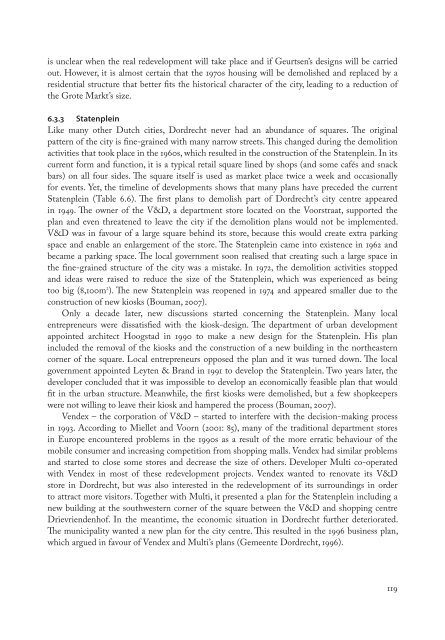Changing public space
Changing public space
Changing public space
Create successful ePaper yourself
Turn your PDF publications into a flip-book with our unique Google optimized e-Paper software.
is unclear when the real redevelopment will take place and if Geurtsen’s designs will be carried<br />
out. However, it is almost certain that the 1970s housing will be demolished and replaced by a<br />
residential structure that better fits the historical character of the city, leading to a reduction of<br />
the Grote Markt’s size.<br />
6.3.3 Statenplein<br />
Like many other Dutch cities, Dordrecht never had an abundance of squares. The original<br />
pattern of the city is fine-grained with many narrow streets. This changed during the demolition<br />
activities that took place in the 1960s, which resulted in the construction of the Statenplein. In its<br />
current form and function, it is a typical retail square lined by shops (and some cafés and snack<br />
bars) on all four sides. The square itself is used as market place twice a week and occasionally<br />
for events. Yet, the timeline of developments shows that many plans have preceded the current<br />
Statenplein (Table 6.6). The first plans to demolish part of Dordrecht’s city centre appeared<br />
in 1949. The owner of the V&D, a department store located on the Voorstraat, supported the<br />
plan and even threatened to leave the city if the demolition plans would not be implemented.<br />
V&D was in favour of a large square behind its store, because this would create extra parking<br />
<strong>space</strong> and enable an enlargement of the store. The Statenplein came into existence in 1962 and<br />
became a parking <strong>space</strong>. The local government soon realised that creating such a large <strong>space</strong> in<br />
the fine-grained structure of the city was a mistake. In 1972, the demolition activities stopped<br />
and ideas were raised to reduce the size of the Statenplein, which was experienced as being<br />
too big (8,100m 2 ). The new Statenplein was reopened in 1974 and appeared smaller due to the<br />
construction of new kiosks (Bouman, 2007).<br />
Only a decade later, new discussions started concerning the Statenplein. Many local<br />
entrepreneurs were dissatisfied with the kiosk-design. The department of urban development<br />
appointed architect Hoogstad in 1990 to make a new design for the Statenplein. His plan<br />
included the removal of the kiosks and the construction of a new building in the northeastern<br />
corner of the square. Local entrepreneurs opposed the plan and it was turned down. The local<br />
government appointed Leyten & Brand in 1991 to develop the Statenplein. Two years later, the<br />
developer concluded that it was impossible to develop an economically feasible plan that would<br />
fit in the urban structure. Meanwhile, the first kiosks were demolished, but a few shopkeepers<br />
were not willing to leave their kiosk and hampered the process (Bouman, 2007).<br />
Vendex – the corporation of V&D – started to interfere with the decision-making process<br />
in 1993. According to Miellet and Voorn (2001: 85), many of the traditional department stores<br />
in Europe encountered problems in the 1990s as a result of the more erratic behaviour of the<br />
mobile consumer and increasing competition from shopping malls. Vendex had similar problems<br />
and started to close some stores and decrease the size of others. Developer Multi co-operated<br />
with Vendex in most of these redevelopment projects. Vendex wanted to renovate its V&D<br />
store in Dordrecht, but was also interested in the redevelopment of its surroundings in order<br />
to attract more visitors. Together with Multi, it presented a plan for the Statenplein including a<br />
new building at the southwestern corner of the square between the V&D and shopping centre<br />
Drievriendenhof. In the meantime, the economic situation in Dordrecht further deteriorated.<br />
The municipality wanted a new plan for the city centre. This resulted in the 1996 business plan,<br />
which argued in favour of Vendex and Multi’s plans (Gemeente Dordrecht, 1996).<br />
119




